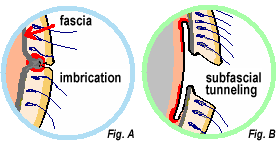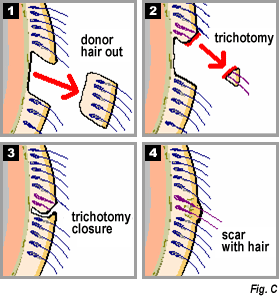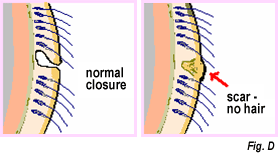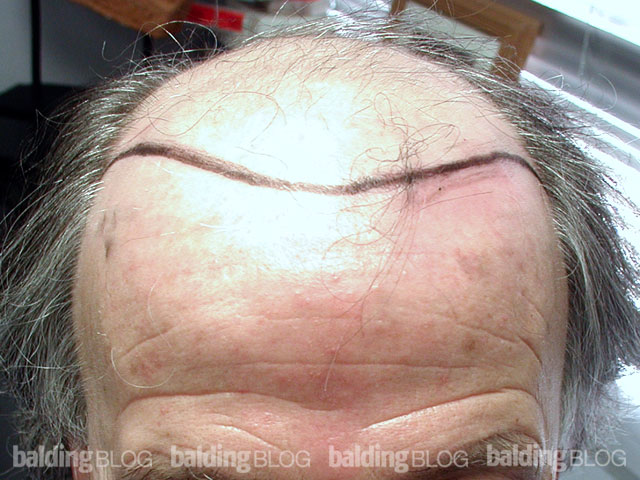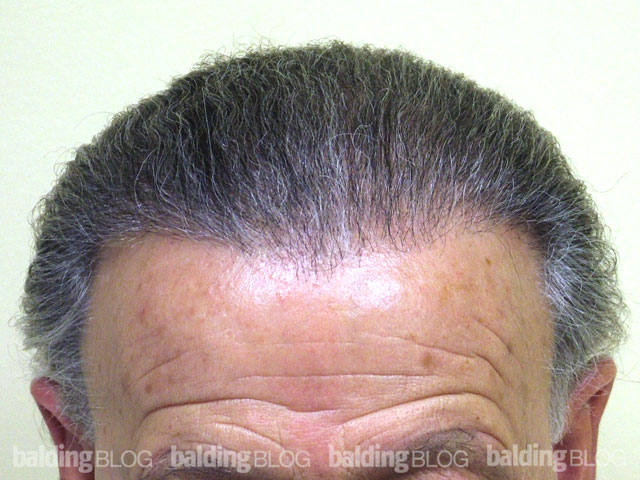Note: This is continued from part 1 that was posted yesterday …
6. I often hear you and others say that stopping Propecia will bring the user to his baseline ‘hair level’ had Propecia never been taken in the first place. This to me seems reasonable, and reassuring. However, I remain a bit skeptical because there is no conceivable way to test that claim. What if hair follicles lose some of their resistance to DHT, simply because they no longer have to deal with it? Is it possible that stopping the drug will make things worse than they would have been? The old “Use it or lose it” saying applies. And this concern carries over to using Minox as well. In case I’m not explaining myself properly, here’s a scenario to illustrate:
Step 1: DHT reaches hair ‘A’.
Step 2: Hair ‘A’ is not adversely affected by DHT.
Step 3: Start using Propecia (presumably to help hairs OTHER than ‘A’).
Step 4: Hair ‘A’ no longer has to ‘fight’ DHT.
Step 5: Stop using Propecia and DHT comes back.
Step 6: Hair ‘A’ is not “prepared” for the DHT onslaught (use it or lose it).
Step 7: Hair ‘A’ is destroyed. Hair ‘A’ would have been fine if Propecia was never used.
How could you say Hair ‘A’ was fine to begin with? The answer is not as simple as A+B=C There are many documented cases where people who gained hair from using Propecia, lost the gained hair when they stopped using Propecia.
7. Propecia has only been around since 1998, Proscar since 1992. So nobody has been on Propecia for more than 8 years. I’m wondering how many people will actually be able to maintain lifetime use of this drug. Unforeseen developments happen in people’s lives all the time, and this should be a pivotal consideration in deciding to go on the drug. Will some situation arise in life that will prevent me from continuing to use Propecia? It’s entirely possible. In your experience, are people able to maintain their use of Propecia, or do you find that people go off the drug at some point?
First, I agree being compliant with any drug therapy for life may be hard. It is definitely something you should consider before starting any elective drug therapy. Likewise, male pattern baldness is also for life. Furthermore, hair transplant is also for life. As you may be aware, these are non frivolous considerations. It is something you and your hair transplant doctor need to consider in making a “Master Plan” for your hair loss.
Second, Proscar is actually protective for prostate cancer.
8. I’ve read your comments in other threads that if a person does not trust the company or the FDA then he should not use their product. This sentiment is all fine and dandy, but things are ne’er so black & white. For instance, recent developments involving Merck & its drug Vioxx cast doubt on the trustworthiness of Merck. And yet that doesn’t mean that Propecia doesn’t work or that its true side-effects have been concealed. Basically I don’t see your point about trustworthiness. Companies have a mandate to increase profits. Sometimes that may lead them to be unscrupulous. Other times they may not need to resort to that. All we can do is ask people in the field, people like yourself, to give us first-hand accounts that will inform our own decisions.
I recommend Propecia to most of my patients with male pattern baldness because I have seen its results first hand. I also recommend Advil for most of my patients with simple arthritis pain.
9. Now, with regards to Minoxidil. I think the general consensus is that Minoxidil plays second fiddle to Propecia when it comes to effectivness. My question is, do you think that Minoxidil is good purely for maintenance, i.e. to prevent further hair loss? Or does the 3-15% statistic that you’ve quoted before apply again? My feeling is that if I go on Minoxidil, eventually I’ll move on to Propecia, so why even bother with Minox in the first place? And there’s something disconcerting about the scientific community not knowing how Minox really works.
You seem to know the answer to this question already!
10. Are Minox & Propecia useful for people who experience what I would call ‘age balding’? That is, people who simply lose a little bit of hair every year throughout their life as part of the regular aging process. Skin doesn’t stay pristine, bones & ligaments don’t either, so should people who don’t experience classic MPB go on these drugs simply to have a fuller head of hair with time? I’ve seen pictures of you (a very handsome man I might add, hehe), and while you’re not bald, I’m sure your hair count is not what it was at 16. Nor do you seem to be suffering from classic MPB. Would you have gone on Propecia or Minox back then to stay looking younger longer?
I am on Propecia now and have been for many years. With regard to your fountain of youth, sorry but there is no such fountain available yet.
11. Personally, I’ve had good hair all my life. Recently, my hairline has matured, and is beginning to look much like my older brother’s. He’s 38, and has a full head of hair, with a widow’s peak (I have one too) and with a slight dracula syndrome (dracula hair with the triangle pattern) whereby there is some degree of temporal hair loss, what is normally termed devil’s horns. When my brother was younger, his hairline was much like mine (although apart from hair, our faces look quite different so I don’t know about relying on my brother’s genetics). He had a widow’s peak with no devil’s horns. I now have progressed to the stage of a low frontal hairline with devil’s horns on the sides just like my brother, maybe a little worse. I can also see the miniaturized hair on the skin where the horns are. If my hair were to stabilize here and progress the way my brother’s hair has, I’d be satisfied. But I don’t want to take chances. Am I wise to embark on this lifelong journey of drugs to prevent the possibility of further loss? I am now at a point where I feel that taking the drugs might restore some of the miniaturized hair, bringing me closer to my freakishly low teenage hairline. But am I being greedy here? These are questions I need to ask of myself, but it’s always good to benefit from the wisdom of others. I’m 23 years old. I do shed quite a bit, and I always have. But I’ve always seen that as a consequence of having a large hair count to begin with. Still, vain as it may be (and I wish I could get past the vanity), I want my hair looking good for as long as possible. But if my hair is not destined to get worse than it presently is, going on drugs would be a waste of money and time. Also, my hair itches often at the sites of hair loss. Moreover I don’t like washing my hair a lot, and I worry that Minox won’t be effective on an oily scalp. I like my scalp to be a little oily for styling purposes so I’ll shower every other day, or every other 2 days (I wash my body daily however). I’m looking for your advice, what you would do if you were in my shoes.
At 23 years old, you may be at the beginning stage of losing your hair. You need a good hair transplant doctor to evaluate the miniaturization process and map your hair loss. If your doctor recommends it, you should then be using any possible Propecia treatment. But with respect to your teenage hairline, I doubt Propecia can restore that.
12. What is the significance of shedding hair with the white bulb at the base, versus shedding hair without the white bulb? Just a general hair question.
The presence of a ‘white’ bulb at the end shows some mucus associated with the hair that you are looking at. Generally the presence of a complete hair follicle with or without a white mucus bulb is of little significance, provided that there are few. There is a specific test that determines to which degree hairs will come out when pulled upon. Normally, only a few hairs will come out of a group of hairs that are pulled upon. What a pull test will show is that if a large percentage of hairs that are pulled upon come out, then some disease process may be going on.
I hope that everything was answered to your satisfaction. If you have more questions, please feel free to comment or contact me.
